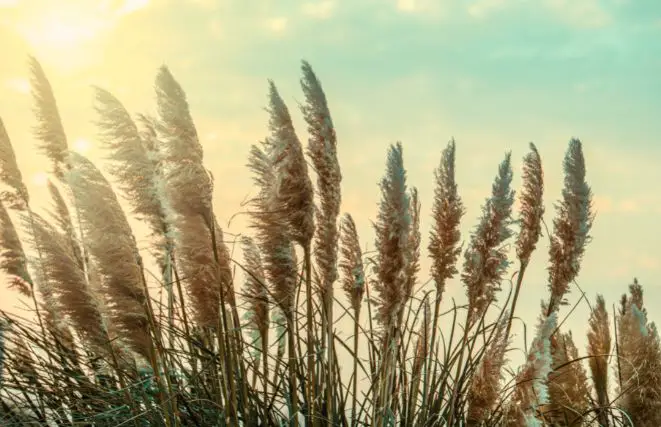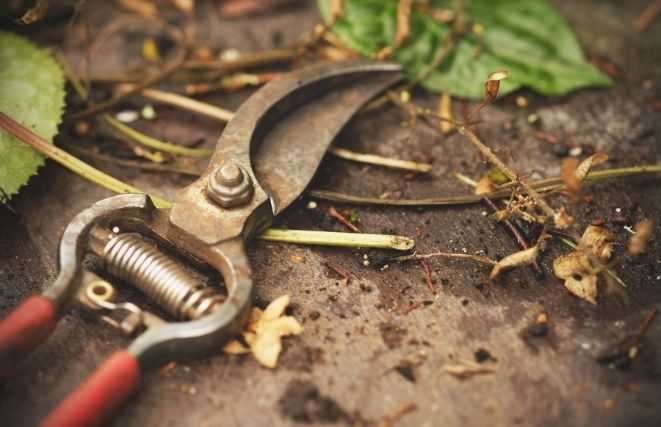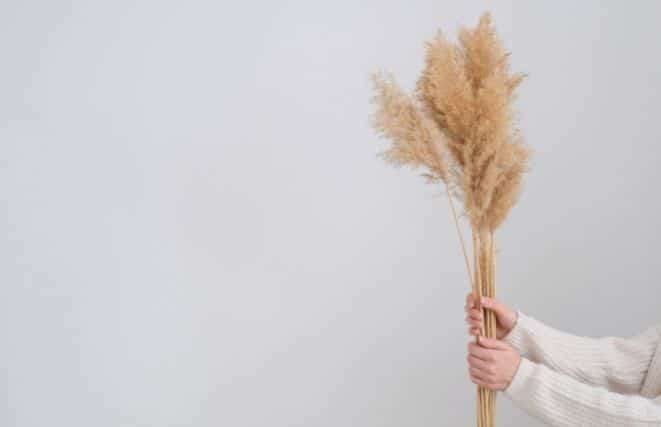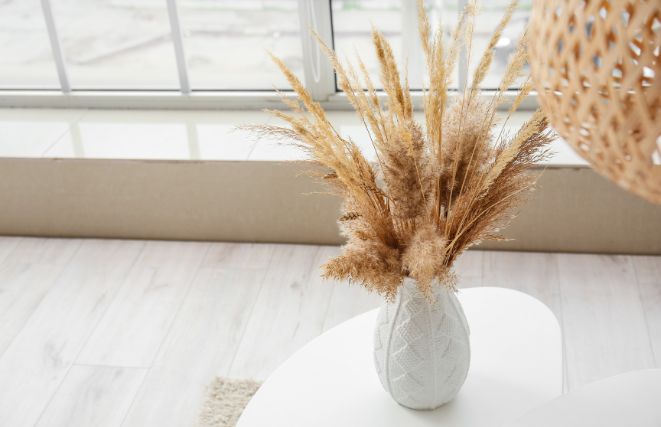Pampas grass is a trendy decor item that adds a natural and bohemian touch to any room. It’s a low-maintenance plant that can last for years with proper care, including drying. Drying pampas grass is an excellent way to preserve its fluffy, feathery plumes and extend its lifespan. In this guide, we’ll show you how to dry pampas grass in a few simple steps.
What Is Pampas Grass?
Pampas grass (Cortaderia selloana) is a tall, flowering grass native to South America. It’s known for its large, feathery plumes that can grow up to 10 feet tall and 4 feet wide. Pampas grass is a popular decorative plant in landscaping and home decor due to its ornamental value and low maintenance requirements.
Why to Dry Pampas Grass?
Drying pampas grass is an excellent way to preserve its fluffy, feathery plumes and extend its lifespan. Fresh pampas grass has a natural green color, but the plumes will eventually dry out and turn beige or white. By drying pampas grass, you can capture this color change and create a beautiful and long-lasting decor item that will add a natural and bohemian touch to any room.
Additionally, dried pampas grass requires little to no maintenance and can last for several years if kept away from direct sunlight and moisture. It’s also a cost-effective way to enjoy the beauty of pampas grass, as dried stems can be reused in different arrangements or crafts.
Tools and Supplies
Must-Have Items:
- Freshly-cut pampas grass
- Pruning shears or scissors
- Rubber bands or string
- A well-ventilated and dry space (such as a garage or attic)
Nice-to-Have Items:
- Gloves (to protect your hands from the sharp edges of the grass)
- Newspaper or a drop cloth (to catch any loose plumes)
How to Dry Pampas Grass
Step 1: Choose the Right Time to Cut Your Pampas Grass
The best time to cut pampas grass is in the fall, between September and November. At this time, the plant is fully matured and has developed the characteristic plumes that make it such a popular decor item. It’s important to cut the grass at the right time to ensure that it’s fully developed and will dry properly.

Step 2: Cut Your Pampas Grass
Using pruning shears or scissors, cut your pampas grass stems as close to the base as possible. Be sure to wear gloves to protect your hands from the sharp edges of the grass. Cut as many stems as you need, depending on how much pampas grass you want to dry.

Step 3: Trim the Plumes
After you’ve cut your pampas grass, trim the plumes to your desired length. You can leave them long or cut them shorter, depending on your preference. Use scissors or pruning shears to trim the plumes to the desired length.

Step 4: Bundle Your Pampas Grass
Gather your pampas grass stems into small bundles, using rubber bands or string to secure them tightly. Make sure the bundles are not too large or heavy, as this can cause them to break or bend during the drying process.
Step 5: Hang Your Bundles
Hang your pampas grass bundles upside down in a well-ventilated and dry space, such as a garage or attic. Make sure the bundles are not touching each other or any other surfaces, as this can cause them to flatten or stick together. It’s also a good idea to place newspaper or a drop cloth beneath the bundles to catch any loose plumes.
Step 6: Wait for Your Pampas Grass to Dry
Your pampas grass will take anywhere from one to four weeks to dry completely, depending on the humidity and temperature of your drying space. Check your bundles regularly to make sure they are drying evenly and not developing any mold or mildew. If you notice any signs of mold or mildew, remove the affected stems and dispose of them immediately.
Step 7: Display Your Dried Pampas Grass
Once your pampas grass is fully dried, you can remove the rubber bands or string and display the plumes in a vase or other decorative container. Dried pampas grass can last for several years with proper care, including occasional dusting and keeping it away from direct sunlight and moisture.

How Long Does Pampas Grass Last?
Dried pampas grass can last for several years if it’s properly cared for. The lifespan of dried pampas grass can vary depending on the quality of the drying process and the storage conditions. If the grass is dried thoroughly and stored in a dry, cool, and dark place away from direct sunlight, moisture, and humidity, it can last 3 years or even longer.
However, if the grass is exposed to sunlight, moisture, or humidity, it can deteriorate quickly, losing its color, texture, and shape.
To extend the lifespan of your dried pampas grass, it’s recommended to keep it away from high-traffic areas, pets, and children, and to gently dust it off from time to time. If you notice any signs of mold, mildew, or pests on your dried pampas grass, it’s important to dispose of it immediately to prevent contamination.
Can I cut Pampas Grass from someone’s Garden?
No, it’s not appropriate to cut pampas grass from someone else’s garden without their permission. Pampas grass is a popular ornamental plant, and many people grow it for its decorative value. Cutting someone else’s pampas grass without permission is considered trespassing and can result in legal consequences.
Even if you know the person and feel comfortable asking for permission, it’s important to respect their property and not cause any damage or disruption to their garden. If you’re interested in using pampas grass for home decor or crafts, it’s best to purchase it from a reputable source or grow it yourself if it’s legal in your area.
How Do I Maintain Pampas Grass Plants?
If you have live pampas grass plants in your garden, it’s important to maintain them properly to ensure their health and longevity. Here are some tips for maintaining pampas grass plants:
- Watering: Pampas grass is drought-tolerant and doesn’t require frequent watering. Water your pampas grass deeply once or twice a week, depending on the weather and soil conditions. Avoid overwatering, as pampas grass can be susceptible to root rot.
- Fertilizing: Pampas grass doesn’t require regular fertilization, but you can apply a slow-release fertilizer in the spring to promote growth and flowering.
- Pruning: Pampas grass can grow up to 10 feet tall and wide, so it’s important to prune it regularly to keep it from becoming overgrown and to promote healthy growth. Prune your pampas grass in late winter or early spring before new growth appears, using sharp pruning shears or a hedge trimmer. Cut the stems back to 1-2 feet above the ground, leaving a few inches of new growth.
- Pest control: Pampas grass is generally pest-resistant, but it can attract aphids, mealybugs, and spider mites. Monitor your plants regularly for signs of infestation, such as yellowing leaves or sticky residue, and treat them with insecticidal soap or neem oil if necessary.
- Division: Pampas grass can become overcrowded and may need to be divided every few years to promote healthy growth. Divide your pampas grass in the spring by digging up the entire plant and separating it into smaller clumps with a sharp spade. Replant the divisions in well-draining soil and water them thoroughly.
By following these maintenance tips, you can keep your pampas grass plants healthy, attractive, and long-lived.
People also ask
To ensure your enjoyment of your new dried plant, we highly recommend following these steps:
1. Gently shake each stem to remove any excessive fur that may have accumulated during shipment. It’s advisable to do this over a paper-covered surface or outdoors to prevent any mess.
2. Place the stems in a vase and allow them to naturally fluff up. After a couple of days, you’ll notice the plumes opening up even more.
Some customers inquire about using hairspray to prevent shedding in pampas grass.
Our personal opinion is that we don’t recommend it. Hairspray tends to make the fur stiff and detracts from the natural fluffiness.
However, if you’re still tempted to try hairspray, we suggest applying a very small amount to the stems only after they have been in the vase for a few days and have fully fluffed up. We advise conducting a small test on a piece first to assess the results and determine if you’re satisfied.
Yes, pampas grass generally becomes fluffier as it dries. When the plumes of pampas grass are freshly cut, they may appear more compact and tightly bundled. However, as the grass dries, the individual strands and feathery plumes begin to expand and separate, creating a fuller and fluffier appearance.
The drying process allows the natural fibers of the pampas grass to relax and unfurl, resulting in a softer and more voluminous texture. As the moisture evaporates from the stems, the plumes expand and take on their characteristic fluffy and feathery appearance. This transformation is what makes dried pampas grass a popular choice for home decor and floral arrangements.
In conclusion
Drying pampas grass is a simple and rewarding process that can help you create beautiful and long-lasting decor items. By following these easy steps, you can preserve the natural beauty of your pampas grass and enjoy it for years to come.








